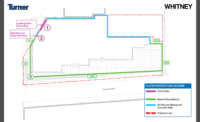

Reconfiguring an airport the size of O'Hare, including building four new runways—without disrupting the 68 million passengers that use it annually—involves challenging staging and logistics. The construction team had to relocate a railroad, a cemetery, cargo facilities and a stormwater retention basin. One new runway will be opening in October, while another is in an active site- preparation stage.
When the overall $6.6-billion O'Hare Modernization Program is complete, O'Hare will have six east-west parallel runways and two crosswind runways. "Once you get to the paving, it's long, straight and flat," says Frank Grimaldi Jr., assistant commissioner of the Chicago Dept. of Aviation. "But getting there, coordinating, having no impact on aircraft operations or safety—those are the hard parts," he says. Each of the construction sequences is very closely coordinated with airfield operations.
Runway 10C/28C, named for its coordinates, now is 99.9% complete, with electrical and concrete finishing work in progress as the Federal Aviation Administration fine-tunes its equipment. "This runway cost about $1.2 billion, and about $700 million of that was moving things out of the way," says James Chilton, OMP program manager from AECOM.
The eastern and western ends of the runway were completed a few years ago, but central section construction—by a joint venture of Walsh Construction, T.J. Lambrect and Terrell Materials Corp.— required the relocations. For example, a cemetery move (ENR 12/12/11 p. 23) involved a genealogy study, which found records on about 900 burials, identifying next of kin. "The city wrote letters to the families asking where they would like the graves relocated, which involved about a half-dozen cemeteries," Chilton says.
Flight Readiness
O'Hare had to have a 13,000-ft-long runway open at all times for international flights, which meant that, before a huge intersecting runway running from the northwest to the southeast could be shortened by 5,000 ft, they had to replace it with another of similar length. A project completed in 2008 added 3,000 ft to the 10,000-ft-long Runway 10L/28R, but that met another obstacle: Union Pacific Railroad track ran right through the site and had to be moved.
But the 2.5 miles of double-track railroad with four permanent bridges couldn't be moved immediately into its final configuration because OMP was still in the process of acquiring the property. It was first moved into an interim configuration—freeing up real estate to relocate cargo facilities—and then moved again into final position.
Earthmoving
"We moved about 24 million cubic yards of soil material on this project, and none of it has left the site," says Grimaldi. Contractors used it in active projects or built berms to store it for future use.
One of the biggest single excavations was made to relocate and expand a stormwater retention basin that also was originally in the path of Runway 10C/28C. The Kiewit/Reyes joint venture excavated about 2.7 million cu yd of soil and used about 2.2 million to fill in the existing basin. "We found out we had a strong upward gradient on the bedrock aquifer," Chilton says. "We put a slurry wall all the way around to minimize the amount of water applying pressure on the basin liner and grouted the aquifer bedrock to shut off as much of the groundwater pressure as possible."
Thomas C. Lyon, OMP south airfield site manager from Parsons Brinckerhoff, adds that, so far, crews have moved 2 million of the 3.5 million cu yd of earth for Runway 10R/28L. Paving will start next year, and the runway is set to open in October 2015.







